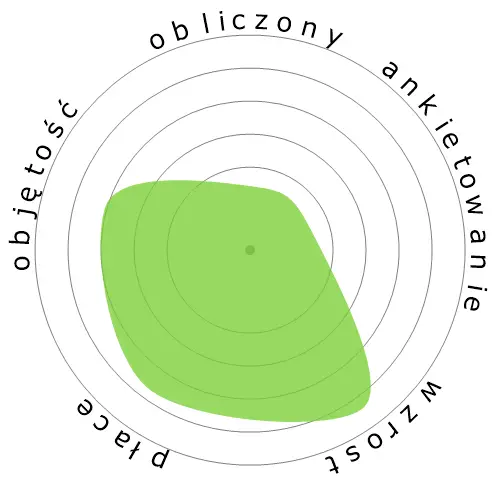Analitycy ds. Inteligencji Biznesowej
Dane zatrudnienia nie są dostępne specjalnie dla tego zawodu z Biura Statystyki Pracy, więc korzystamy z danych z Data Scientists.




Ludzie również oglądali
Obliczone ryzyko automatyzacji
Wysokie ryzyko (61-80%): Zawody w tej kategorii stoją przed znaczącym zagrożeniem ze strony automatyzacji, ponieważ wiele z ich zadań może być łatwo zautomatyzowanych przy użyciu obecnych lub bliskich przyszłości technologii.
Więcej informacji na temat tego, czym jest ten wynik i jak jest obliczany, jest dostępne tutaj.
Ankieta użytkownika
Nasi goście głosowali, że jest prawdopodobne, iż to zawód zostanie zautomatyzowany. To ocena jest dodatkowo wspierana przez obliczony poziom ryzyka automatyzacji, który szacuje 74% szansę na automatyzację.
Jakie są Twoje zdanie na temat ryzyka automatyzacji?
Jakie jest prawdopodobieństwo, że Analitycy ds. Inteligencji Biznesowej zostanie zastąpione przez roboty lub sztuczną inteligencję w ciągu najbliższych 20 lat?
Nastroje
Poniższy wykres jest zamieszczany wszędzie tam, gdzie istnieje znaczna liczba głosów, aby przedstawić istotne dane. Te wizualne reprezentacje pokazują wyniki ankiet użytkowników w czasie, dostarczając istotnych wskazówek dotyczących trendów nastrojów.
Nastroje w czasie (rocznie)
Wzrost
Liczba ofert pracy na stanowisku 'Data Scientists' ma wzrosnąć 36,0% do 2033
Zaktualizowane prognozy mają być dostępne 09-2025.
Płace
W 2023, mediana rocznej pensji dla 'Data Scientists' wynosiła 108 020 $, czyli 51 $ za godzinę.
'Data Scientists' otrzymali wynagrodzenie wyższe o 124,8% od średniej krajowej, która wynosiła 48 060 $
Objętość
Od 2023 roku zatrudnionych było 192 710 osób na stanowisku 'Data Scientists' w Stanach Zjednoczonych.
To oznacza około 0,13% zatrudnionej siły roboczej w całym kraju.
Inaczej mówiąc, około 1 na 787 osób jest zatrudnionych jako 'Data Scientists'.
Opis stanowiska pracy
Produkuj informacje finansowe i rynkowe, odpytując repozytoria danych i generując okresowe raporty. Opracuj metody identyfikacji wzorców i trendów danych w dostępnych źródłach informacji.
SOC Code: 15-2051.01


Komentarze
Leave a comment
The bulk of my time as a BI analyst is spent on 2 things. The first is working with domain stakeholders without technical knowledge (marketers in my case). This can often be like herding cats. Lots of people will have lots of different opinions on what KPIs they want to track or how to track them. And often they don't really understand the data limitations of what we can and can't report on, so I need to be there to provide guidance. Much of my job is spent guiding these people along, often massaging their egos along the way, so that the wider group of people arrives at a consensus.
The second is ETL. Even with whole teams of data engineers and operations managers, data is very rarely centralised into a single and easy to understand model. I work with about half a dozen different types of data sources (from AWS to Google Sheets). Each of these have hundreds of different indexes and many of those indexes have hundreds of fields. A tiny fraction of these fields have any kind of documentation and so all you have to go on is the metadata and the name of the db managers who put it together. Actually tracking down the data you need requires getting really into the weeds and following up with multiple people to try to track down who actually knows where to find the data you're looking for. That's just nowhere near enough data for an AI to get a hold of the data it needs.
It is a field where people usually believe in other people rather than AI.
The ETL process is also a complicated, one which most AI is not nor ever may be able to handle, data needs to be cleaned and standardized before AI can take a crack at it, the "AI" and yes I have to put that in quotes does not understand the context of anything, it is a prediction model using gradient boosters that performs quite well under controlled circumstances, thrown into any critical thought role it starts to lose pace. Furthermore nobody who works in the AI space authoring models ands understands the inner workings of "AI" treats this as anything more than a highly sophisticated toy...maybe in another 10 years we can come back to this question and see if we should start to worry.
I spend half of my time maintaining, tweaking, and fixing automation jobs - these include dashboards, data sets, and database tables.
It requires a technical person who is also an expert in their business domain to translate business requirements into data or reports that others need.
Zostaw odpowiedź na temat tego zawodu